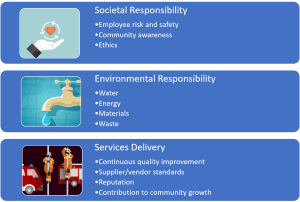Fire departments are not businesses, but we don’t have to look far to find examples of private sector management practices adopted into the fire service. Perhaps the most well-known example is Alan Brunacini embracing the concept of customer service and spreading the message of “Mrs. Smith” far and wide. Today, fire departments regularly talk about how they serve their customers, but if you’ve been in the fire service for a while, you remember the debate this concept initially provoked.
Many other practices developed in the private sector—including those involving time management, staffing, human resources and job safety—have, by law or practical acceptance, been absorbed into the fire service. Some practice adoptions change how we perform a specific or particular function, while some go right to foundations of behavior and culture.
Policy provides an important foundation—one that can emphasize that sustainability isn’t some lofty goal, but rather a concept integrated into all facets of our operations.
One of the practices we see creating foundational change in the corporate world deserves our attention: sustainability. Corporate sustainability is an alternative to the traditional growth and profit-maximization model of doing business. Rather than putting corporate growth and profitability above all else, businesses that embrace corporate sustainability also adopt goals relating to environmental protection, social justice and equity, and economic development.
Like customer service, sustainability is a concept with broad application to the fire service. It starts with our oath to help anyone, no matter their demographics, politics or ability to pay. But it goes much further than that.
What Is Fire Department Sustainability?
You may be thinking, “I know what sustainability is; my department practices it because the city/county requires it.” Like the story of the six blind men and the elephant, however, many fire service personnel are familiar with just one or two aspects of sustainability, such as green fire station design or sustainable recruitment and retention. Sustainability encompasses much more, and so much of it can carry over to the fire service, all to the benefit of our departments, members and those we serve.
We can better understand the scope of fire department sustainability if we separate it into three parts:
Each of these parts could constitute an article in itself. Our focus, however, is not on the detailed programs involved in each of these areas, but rather how fire department policy more broadly can be used to support sustainability goals.
Using Policy to Support a Sustainable Fire Department
Adopting a fire department sustainability program may seem overwhelming—until you realize many of your fire department’s policies can be used to encourage behaviors that reinforce sustainability practices. When we implement and train on good policy, the resulting behavior influences fire department culture. Looked at from this perspective, building sustainability into the department’s culture is not such a long leap in terms of both cost and effort.
Policies addressing societal responsibility include those that address:
- Workplace safety, including the department’s commitment to adhere to laws and best practices and provide the necessary training and equipment
- Worker’s rights as provided by law, including a commitment to adhere to and enforce those rights
- Member health and wellness, including mental health
- Recruitment and retention
- How the department interacts with the community it serves, including employee conduct, anti-discrimination, community volunteer programs and firehouse visitation programs
- Public education and fire prevention
- Department ethics, including the Code of Ethics and a commitment to conduct all internal and external matters in an ethical manner, together with a confidential and non-retaliatory process to report unethical behaviors and policy violations.
Policies addressing environmental responsibility include those that address:
- Water usage, water conservation and wastewater management at the station, during training and when responding to fires and other emergencies
- Energy usage and energy conservation, including use of energy-saving devices and technology standards for new and remodeled stations
- Efforts to purchase alternatives to single-use consumer products and to recycle materials where possible
Like customer service, sustainability is a concept with broad application to the fire service. It starts with our oath to help anyone, no matter their demographics, politics or ability to pay.
Policies addressing services delivery include those that address:
- Emergency response, including emphasis on safe response that protects members and the public from unnecessary risk
- Emergency response time standards
- Securing and protecting property during fireground operations
- The department’s commitment to delivery of public information through established procedures
- Annual reporting requirements on department activities and services provided and associated costs
- The need for suppliers to adhere to the same high standards followed by the department, including safety and workplace practices in the supply chain. (If the concept of asking your suppliers to submit proof they adhere to standards seems uncomfortable, remember you’re probably not the first to ask. It’s increasingly likely a private sector customer has asked your glove or other apparel supplier to provide an independent third-party supply chain audit or certification. The reputational damage and risk of purchasing items produced by a company using forced labor or illegal labor practices becomes higher and higher. Publicly traded and privately held businesses won’t tolerate it and we shouldn’t either.)
Your department probably has many of these policies already in place. Building a sustainability program can start with identifying existing policies that address sustainability, editing policies to reinforce sustainability concepts, and adding policies where needed. Again, training on those policies reinforces member behavior, further integrating sustainability into department culture. Be sure to coordinate public awareness of the program.
Of course, policies alone don’t transform your firehouse into a “green” station or ensure you’re meeting or exceeding response times; this requires leaders and all members to carry out the policies in day-to-day actions and long-term strategic planning. But policy provides an essential foundation, emphasizing that sustainability isn’t some lofty goal, but rather a concept integrated into all facets of our operations.
Safer, Smarter, Stronger
Corporate America has discovered that sustainability isn’t just the right thing to do; it delivers benefits to the company’s bottom line. In the fire service, sustainability also delivers valuable and tangible benefits, creating a safer, smarter and stronger fire department. Safer through commitment to the safety of all members, the public we serve and all workers in the supply chain of products and services the department receives. Smarter through commitment to innovative services and processes for sustainable and long-term performance. And stronger through commitment to follow-through on sustainability initiatives.
Reference
- Wilson M. (2003) Corporate sustainability: What is it and where does it come from? Ivey Business Journal.




